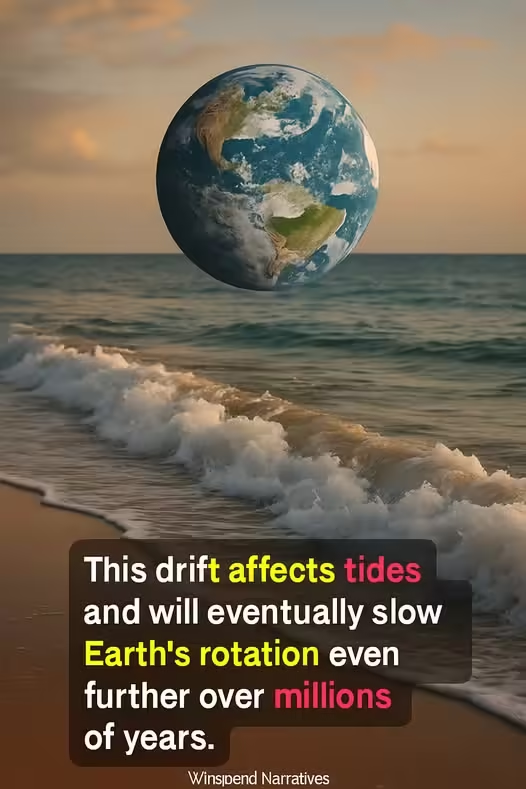
The Moon’s Silent Pull: How Earth’s Celestial Companion Shapes Our Destiny
Look up at the night sky and you’ll see Earth’s constant companion — the Moon, glowing softly and faithfully orbiting our planet. It has inspired poets, guided sailors, and marked the passage of time for millennia. But beyond its romantic and cultural significance, the Moon plays a vital role in the stability and future of our planet. It’s a cosmic partner in a slow but profound dance that subtly affects everything from ocean tides to climate stability and even the length of our days.
What many don’t realize is that this relationship is slowly changing. Thanks to precise measurements, scientists have discovered that the Moon is gradually moving away from Earth. This seemingly small movement has sweeping implications, not just for our planet’s present, but for its far future.
The Moon Is Drifting Away
The evidence of the Moon’s recession comes from an extraordinary scientific instrument left behind during the Apollo missions: laser reflectors. When astronauts placed these reflectors on the lunar surface in the 1960s and 1970s, they enabled scientists on Earth to bounce laser beams off them and measure the round-trip travel time with astonishing accuracy.
What these experiments revealed was surprising: the Moon is receding from Earth at a rate of about 3.8 centimeters per year (roughly 1.5 inches). That may not sound like much, but over millions or billions of years, this slow drift leads to significant changes in the gravitational relationship between Earth and the Moon.
Tidal Forces: A Gravitational Tug-of-War
Why is the Moon moving away? It all comes down to tidal forces — the gravitational pull between the Earth and Moon that causes the rise and fall of ocean tides.
As the Moon’s gravity pulls on Earth’s oceans, it creates tidal bulges on our planet. Because Earth rotates faster than the Moon orbits, these bulges are slightly ahead of the Moon. This leads to a transfer of rotational energy from Earth to the Moon. As a result, Earth’s rotation gradually slows down, and the Moon is pushed farther away in its orbit.
This energy exchange is incredibly slow, but it’s persistent. Over hundreds of millions of years, it adds up, and both the length of Earth’s day and the distance to the Moon have changed significantly. In fact, around 620 million years ago, a day on Earth was only about 21 hours long.
A Slower Earth: Lengthening of Days
As the Moon continues to drift away, Earth’s rotation continues to slow. That means the length of a day is increasing — albeit very slowly. Today, a day is 24 hours long, but in a few billion years, that could stretch out significantly. Some scientists estimate that if the trend continues, Earth’s days could eventually last 40 hours or more.
While this process won’t affect our daily lives anytime soon, it’s a powerful reminder that even something as seemingly constant as the 24-hour day is subject to cosmic change. The slowing rotation of our planet is a direct result of our relationship with the Moon.
The Moon’s Role in Climate Stability
But the Moon’s influence isn’t limited to tides and timekeeping. One of its most critical functions is in stabilizing Earth’s axial tilt — the angle between Earth’s rotational axis and its orbital plane.
Currently, Earth’s axis is tilted about 23.5 degrees, which is responsible for our seasons. This tilt doesn’t remain perfectly fixed, but thanks to the Moon’s gravitational influence, it wobbles only slightly — within a narrow range. Without the Moon, Earth’s tilt could vary wildly over time, potentially swinging between 0 to 85 degrees.
Such extreme variations would have devastating impacts on the planet’s climate. A greater tilt might lead to intense seasons, where summers are scorchingly hot and winters are brutally cold. A smaller tilt might eliminate seasons altogether. In both cases, such changes would make Earth far less hospitable for life.
So, while it silently orbits our world, the Moon helps maintain the conditions that allow life to thrive. It acts as a cosmic stabilizer, moderating the forces that would otherwise cause Earth’s climate to spiral into chaos.
A Future Without the Moon?
What happens in the distant future, as the Moon continues to drift away? If we fast forward billions of years, the Earth and Moon could eventually reach a state of tidal locking, where Earth’s rotation matches the Moon’s orbit, just as the Moon is already tidally locked to Earth — always showing the same face.
But long before that point, Earth’s days will have lengthened considerably, and the Moon’s influence will have diminished. Tidal effects will weaken, potentially disrupting ocean currents and ecosystems that rely on regular tidal rhythms. The axial stability the Moon provides could fade, allowing Earth’s tilt to wobble more freely, triggering climatic upheavals over geological timescales.
If life still exists on Earth in that far-off future, it might experience a planet very different from the one we know today — with longer days, altered tides, and a more volatile climate. The Moon’s eventual distancing is not just a loss of a companion in the sky, but a transformation of the delicate balance that makes Earth livable.
The Moon’s Legacy
It’s easy to take the Moon for granted. It rises and sets each night, silently glowing, changing phases in a rhythm older than humanity. But behind that tranquil beauty is a profound dynamic at work — one that has shaped the evolution of life, the rhythm of time, and the climate systems we depend on.
The Moon is more than just a satellite. It is a silent architect of Earth’s stability. Its presence makes our world what it is. And while it slowly retreats into the cosmic distance, its legacy will continue for eons.
In Conclusion
The Moon may seem distant, cold, and unchanging. But it’s a dynamic participant in Earth’s journey through space and time. Thanks to the Apollo-era laser reflectors and continued observations, we know that it’s slowly slipping away, and with it, the gravitational handshake that binds it to Earth is weakening.
This slow-motion dance is shaping the destiny of our planet. From the lengthening of our days to the stability of our climate, the Moon’s impact is immense. And as it recedes, it leaves behind a changing world — one where the forces it once balanced may fall out of harmony.
So the next time you gaze up at the Moon, remember: you’re looking at one of the most important influences on life as we know it — a silent guardian of Earth’s cosmic balance.


